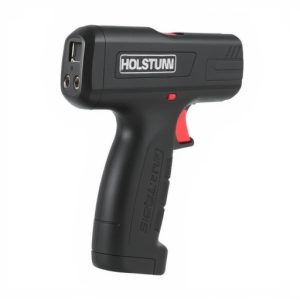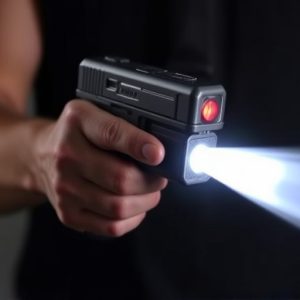How Does a Stun Gun Work Through Thick Clothing?
Stun guns, or electronic control devices (ECDs), use high-voltage, low-current electric pulses to te…….
Stun guns, or electronic control devices (ECDs), use high-voltage, low-current electric pulses to temporarily disable targets by overwhelming muscular control. Their effectiveness depends on voltage penetration through clothing, influenced by material, moisture content, and thickness. Safety precautions, such as protective clothing and specialized gear, are crucial when handling stun guns due to electrical hazards. While challenges exist with fabric resistance, modern stun guns remain valuable tools for quick threat neutralization in various conditions. Understanding how stun guns work is key to optimizing their performance in real-world scenarios.
Voltage penetration through thick clothing is a critical aspect of understanding the effectiveness of stun guns. In this comprehensive guide, we’ll explore how these devices operate and delve into the science behind their shock technology. We’ll analyze various factors influencing voltage transmission, including material composition and thickness. Additionally, safety precautions related to protective clothing will be discussed, along with real-world applications and the overall effectiveness of stun guns when targeting individuals wearing thick fabrics.
- Understanding Stun Guns: The Technology Behind the Shock
- Factors Influencing Voltage Penetration: A Deep Dive
- Safety Considerations: Wearing Protective Clothing
- Real-World Applications and Effectiveness of Stun Guns Through Thick Fabrics
Understanding Stun Guns: The Technology Behind the Shock
Stun guns, also known as electronic control devices (ECDs), utilize advanced technology to deliver powerful electrical shocks that temporarily incapacitate a target. The device emits a high-voltage, low-current electric pulse through metal prongs or electrodes when activated. This voltage penetration is designed to disrupt the nervous system’s proper functioning, specifically targeting muscle control and balance.
The shock from a stun gun overloads the body’s electrical systems, causing muscles to contract uncontrollably. This sudden jolt of electricity can immobilize an individual for several minutes, providing users with a crucial window of opportunity for self-defense or law enforcement intervention. The technology behind stun guns has evolved significantly, ensuring their effectiveness and safety while promoting responsible use.
Factors Influencing Voltage Penetration: A Deep Dive
Understanding how a stun gun works is crucial in gauging voltage penetration through thick clothing. The effectiveness of a stun device depends on several factors, from the device’s electrical output to the type and thickness of the fabric it encounters. The current flow through the body is interrupted by the clothes, acting as an insulator, which can significantly reduce the voltage delivered to the target area.
Material composition and moisture content also play a significant role. Dry fabrics conduct electricity better than moist ones, so the resistance offered to electric current changes with humidity levels. Moreover, the thickness of the clothing is a primary determinant; thicker fabrics provide more insulation, thereby reducing the penetration depth of the voltage. This is why stun guns are designed to adapt their output based on different scenarios and materials, ensuring optimal shock intensity despite variations in clothing conditions.
Safety Considerations: Wearing Protective Clothing
When considering safety in situations involving high voltage, one crucial aspect is protective clothing. In many cases, especially when dealing with power lines or other electrical hazards, proper attire can significantly reduce the risk of severe injury or death. This is particularly relevant when discussing how a stun gun works; while not directly related to voltage penetration through clothing, understanding safety precautions is essential.
Wearers of protective gear, including specialized insulated gloves and boots, can create a barrier against electric current flow. These items are designed to dissipate energy, preventing it from reaching the body’s vital organs. It’s important to note that while thick clothing may offer some protection, not all fabrics conduct electricity equally. For instance, leather and certain synthetic materials with high resistance properties can provide better shielding than cotton or other more conductive textiles.
Real-World Applications and Effectiveness of Stun Guns Through Thick Fabrics
In real-world scenarios, the effectiveness of stun guns in penetrating thick fabrics has both practical and legal implications. Stun guns, also known for their ability to temporarily incapacitate targets, operate by delivering an electric shock through a pair of electrodes. When deployed against individuals wearing heavy clothing, such as jackets or coats, the current must travel through the fabric before reaching the body. While some fabrics may impede the flow of electricity, many modern stun guns are designed with this challenge in mind, utilizing high-power outputs to compensate for resistance.
The success of a stun gun against thick fabrics depends on several factors, including the thickness and material of the clothing, as well as the device’s specifications, like voltage and current. In applications where officers or individuals need to subdue potential threats quickly in challenging conditions, stun guns remain a valuable tool. However, it is crucial to understand their limitations and ensure proper usage, especially considering that not all fabrics conduct electricity in the same manner.
Understanding how a stun gun works, the factors affecting voltage penetration through thick clothing, and safety considerations involving protective gear is key to evaluating their real-world applications. While these devices can be effective in certain scenarios, it’s crucial to recognize their limitations when faced with robust fabrics. By considering these aspects, users can make informed decisions regarding the appropriateness of stun guns in specific situations.


